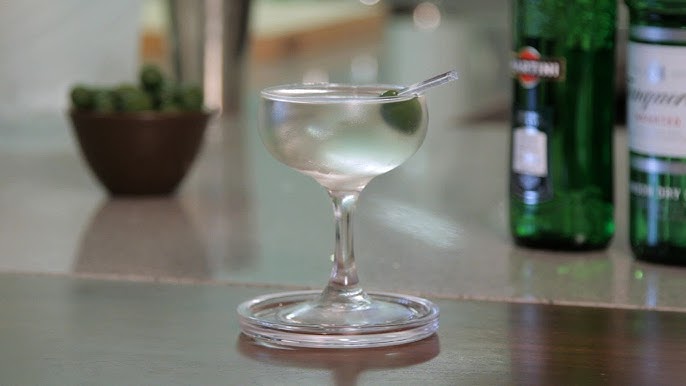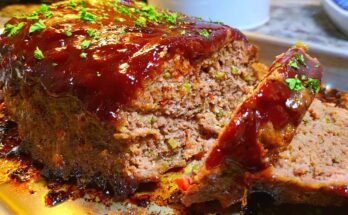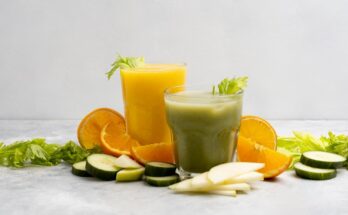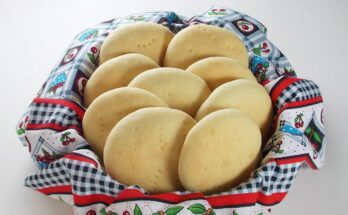Gin Martini Recipe: A Gin Martini is a timeless and sophisticated cocktail known for its elegance and simplicity. Made with gin and vermouth, it’s typically served in a chilled martini glass with either an olive or a twist of lemon peel as garnish. This drink is loved by cocktail enthusiasts for its smooth flavor and versatility, making it perfect for any occasion.
The History of the Gin Martini
The origins of the Gin Martini trace back to the mid-19th century, with various stories linking it to bartenders in California and New York. Over the decades, the martini evolved, becoming a symbol of class and style. Popularized in films and books, especially by James Bond, the martini has solidified its place as one of the most iconic cocktails ever created.
Ingredients Needed for a Classic Gin Martini
Essential Ingredients
To make a perfect Gin Martini, you only need a few key ingredients:
- Gin (2 ½ ounces): Choose a high-quality gin to enhance the flavor.
- Dry Vermouth (½ ounce): Provides a subtle herbal undertone.
- Ice Cubes: For chilling the drink properly.
- Garnish: Either a green olive or a lemon twist.
Choosing the Right Gin
The gin you select significantly impacts the flavor. Options include:
- London Dry Gin: Crisp and juniper-forward.
- Plymouth Gin: Smoother and slightly sweeter.
- Old Tom Gin: Slightly sweeter, suitable for those who prefer less bitterness.
The Role of Vermouth in a Martini
Vermouth is a fortified wine infused with botanicals. Dry vermouth adds herbal notes, balancing the gin’s strength. The ratio of gin to vermouth determines whether your martini is dry (less vermouth) or wet (more vermouth).
Tools and Glassware You’ll Need
Must-Have Bar Tools
- Mixing Glass or Shaker: For mixing or shaking the ingredients.
- Bar Spoon: Ensures smooth stirring without over-dilution.
- Strainer: Filters out ice while pouring.
- Jigger: Provides accurate measurements.
Martini Glass Selection
Martini glasses, known for their V-shape, enhance the visual appeal and maintain the drink’s temperature. Always pre-chill the glass for the best results.
Step 1 – Chill Your Glass and Tools
Why Chilling Is Important
A cold martini tastes better because it preserves the crispness of the gin and vermouth while preventing dilution. Room-temperature glasses can quickly warm the drink, compromising its flavor.
Pro Tips for Chilling Glassware
- Fill your martini glass with ice water and let it sit while you prepare the ingredients.
- Alternatively, place the glass in the freezer for 10–15 minutes.
- Keep your mixing glass and tools cold as well for optimal results.
Step 2 – Measure and Pour Ingredients
Measuring Gin and Vermouth
- 2 ½ ounces of gin for the body of the drink.
- ½ ounce of dry vermouth to add complexity.
Balancing the Perfect Ratio
- For a dry martini, use a 5:1 gin-to-vermouth ratio.
- For a wet martini, try a 2:1 ratio.
- Adjust according to your personal preference.
Use a jigger to measure precisely and pour the ingredients into the mixing glass.
Step 3 – Stir or Shake? The Great Debate
Stirring vs. Shaking: Pros and Cons
- Stirring: Provides a silky texture and keeps the drink clear. Preferred by purists.
- Shaking: Creates a slightly cloudy appearance and dilutes the drink faster. Popularized by James Bond’s “shaken, not stirred” order.
When to Stir and When to Shake
- Stir when using clear spirits like gin and vermouth to preserve clarity.
- Shake if you prefer a lighter, more diluted martini.
Fill your mixing glass with ice, then stir or shake gently for 30 seconds to achieve the right temperature and dilution.
Step 4 – Strain and Serve
Proper Straining Technique
- Place a fine strainer over the mouth of your glass.
- Pour the martini slowly to avoid spills and bubbles.
Presentation Tips for Elegance
- Serve in a pre-chilled martini glass to maintain its cool temperature.
- Hold the glass by the stem to avoid warming the drink.
Step 5 – Garnishing Your Gin Martini
Olive vs. Lemon Twist
- Olive: Adds a slight brininess, complementing the botanicals in gin.
- Lemon Twist: Provides a fresh, citrusy aroma and flavor.
Creative Garnish Ideas
- Cocktail Onion (Gibson Martini): For a unique twist.
- Caper Berries: Adds a gourmet touch.
- Herbs (like rosemary): Enhances aroma and appearance.
Variations on the Classic Gin Martini
Dirty Martini
The Dirty Martini is a popular variation that includes olive brine, adding a salty, savory flavor.
- Ingredients:
- 2 ½ ounces of gin
- ½ ounce of dry vermouth
- ½ ounce of olive brine
- Garnish: Green olives
- Steps:
- Combine gin, vermouth, and olive brine in a mixing glass filled with ice.
- Stir or shake, depending on your preference.
- Strain into a chilled martini glass and garnish with olives.
Dry Martini
A Dry Martini minimizes the vermouth, letting the gin take center stage.
- Ingredients:
- 3 ounces of gin
- A dash of dry vermouth
- Garnish: Lemon twist or olive
- Steps:
- Add gin and a tiny amount of vermouth to your mixing glass with ice.
- Stir until well chilled.
- Strain into a chilled glass and garnish elegantly.
Gibson Martini
The Gibson Martini replaces the olive or lemon twist with a cocktail onion, adding a subtly sweet flavor.
- Ingredients:
- 2 ½ ounces of gin
- ½ ounce of dry vermouth
- Garnish: Pearl onion
- Steps:
- Stir gin and vermouth over ice in a mixing glass.
- Strain into a martini glass.
- Add a cocktail onion for garnish.
Expert Tips for Making the Best Gin Martini
Temperature Control
Always serve a martini as cold as possible. Warm martinis lose their refreshing taste, so:
- Chill your glass in the freezer.
- Use plenty of ice in your mixing glass.
- Stir long enough (30–45 seconds) to ensure proper chilling without over-diluting.
Ingredient Quality and Proportions
- Gin Quality: Opt for premium gins with rich botanical flavors.
- Vermouth Freshness: Store vermouth in the fridge after opening to maintain freshness.
- Ratios: Experiment with ratios to suit your taste—classic, dry, or dirty.
Common Mistakes to Avoid
Over-Dilution
Over-stirring or shaking for too long can make your martini watery. Stir for just the right amount of time—usually 30 seconds—until the mixture feels ice-cold.
Incorrect Ratios
An imbalance between gin and vermouth can throw off the flavor. Measure ingredients carefully to maintain consistency. If experimenting, test small amounts before committing to full servings.
Serving and Pairing Suggestions
Best Foods to Pair with a Gin Martini
A Gin Martini pairs beautifully with a variety of foods:
- Seafood: Oysters, shrimp cocktail, and smoked salmon complement its crispness.
- Cheese and Crackers: Soft cheeses like brie or goat cheese balance the martini’s botanicals.
- Olives and Nuts: Salty snacks enhance the savory elements.
Occasions to Serve a Martini
- Cocktail Parties: Elevate social gatherings with this timeless drink.
- Dinner Dates: Impress guests with a classy pre-dinner cocktail.
- Special Celebrations: Perfect for toasts and anniversaries.
Health Considerations and Moderation
Alcohol Content Awareness
Gin Martinis are strong drinks, often containing 30–40% alcohol by volume. Be mindful of your intake to avoid overconsumption.
Enjoying Responsibly
Drink slowly, sip with intention, and always alternate alcoholic beverages with water to stay hydrated.
FAQs about Gin Martini Recipe
What are the essential ingredients for a classic Gin Martini?
A classic Gin Martini requires just a few key ingredients: high-quality gin, dry vermouth, and ice. Garnishes typically include either a lemon twist or green olives.
How much gin and vermouth should I use for a Gin Martini?
The ratio of gin to vermouth can vary based on personal taste, but a common starting point is 6 parts gin to 1 part vermouth. Adjust the proportions to suit your preference.
Should I stir or shake a Gin Martini?
Traditionally, a Gin Martini is stirred to prevent the gin from becoming overly diluted and to maintain a smooth texture. Shaking can introduce air bubbles and make the drink slightly cloudy.
What type of glass is best for serving a Gin Martini?
A Gin Martini is best served in a chilled martini glass. This enhances the flavor and keeps the drink at an optimal temperature.
Can I make a Gin Martini without vermouth?
While vermouth is a staple ingredient in a classic Martini, you can make a “dry” Martini by minimizing or omitting the vermouth. Remember, the more you reduce the vermouth, the “drier” your Martini becomes.
What are some popular variations of the Gin Martini?
Popular variations include the Dirty Martini, which includes a bit of olive brine for a salty twist, and the Gibson, which is garnished with a cocktail onion instead of an olive or lemon twist.
Conclusion
The Gin Martini is a cocktail that embodies elegance, simplicity, and versatility. Whether you enjoy it dry, dirty, or with a twist, this iconic drink never goes out of style. By following this step-by-step guide, you’ll master the art of crafting the perfect martini to impress friends, family, or even just yourself. Cheers to timeless sophistication in a glass!



